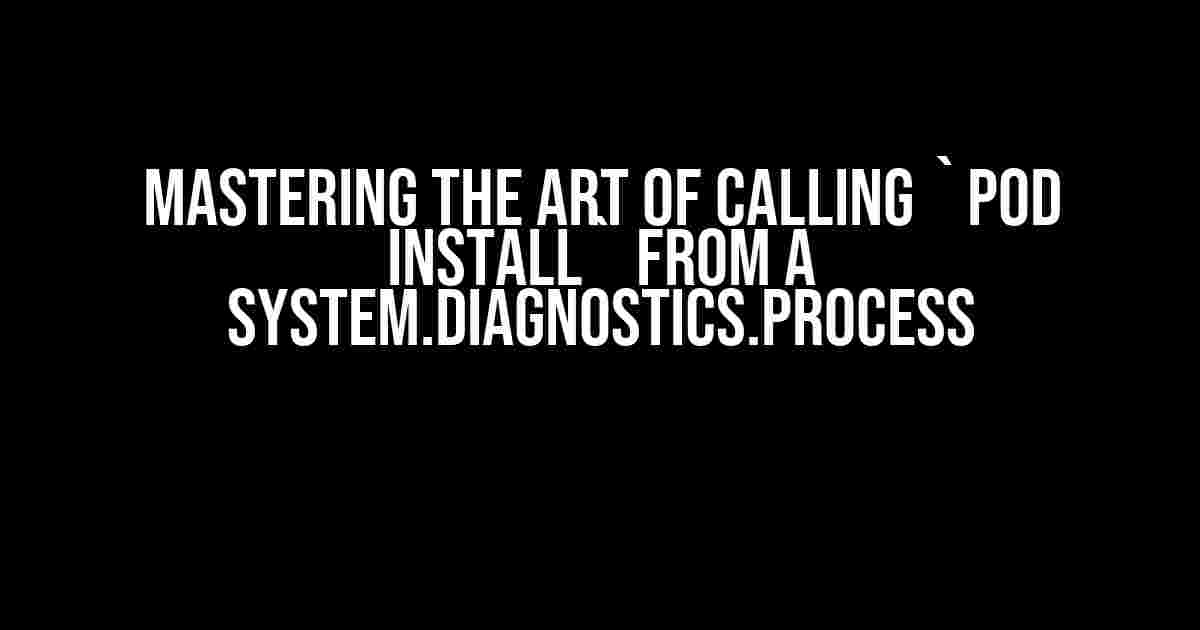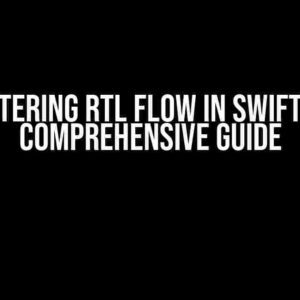Welcome to this comprehensive guide on calling `pod install` from a System.Diagnostics.Process! If you’re reading this, chances are you’re tired of manually running `pod install` every time you need to update your CocoaPods dependencies. Fear not, dear reader, for we’re about to dive into the wonderful world of automated process execution.
What is `pod install` and Why Do I Need to Run it?
If you’re new to iOS development or haven’t ventured into the realm of CocoaPods, let’s take a step back and discuss what `pod install` does. `Pod install` is a command that updates and installs your project’s dependencies specified in your `Podfile`. It’s an essential step in the development process, ensuring that your project has the necessary libraries to compile and run smoothly.
Think of `pod install` as a refresher for your project’s dependencies. Every time you add a new pod to your `Podfile` or update an existing one, you need to run `pod install` to reflect those changes in your project. It’s a crucial step, but it can become tedious and time-consuming, especially when working on large projects or with multiple contributors.
Why Call `pod install` from a System.Diagnostics.Process?
Now that we’ve covered the importance of `pod install`, let’s discuss why calling it from a System.Diagnostics.Process is a game-changer. By automating the `pod install` process, you can:
- Save time and effort by eliminating manual intervention
- Ensure consistency across your development team and environment
- Automate tasks and reduce the risk of human error
- Integrate `pod install` with your CI/CD pipeline for seamless Continuous Integration and Continuous Deployment
By calling `pod install` from a System.Diagnostics.Process, you can integrate it with your existing development workflow, making it an integral part of your project’s build process.
Preparing Your Environment
Before we dive into the code, make sure you have the following installed on your system:
- .NET Core 3.1 or later (required for System.Diagnostics.Process)
- CocoaPods (required for pod install)
If you’re using Visual Studio or Visual Studio Code, create a new .NET Core Console App project to follow along with this tutorial.
The Code: Calling `pod install` from a System.Diagnostics.Process
using System;
using System.Diagnostics;
class PodInstaller
{
static void Main(string[] args)
{
// Set the working directory to your project's root
string workingDirectory = @"C:\Path\To\Your\Project";
// Set the command to run pod install
string command = "pod install";
// Create a new process to run the command
var process = new Process
{
StartInfo = new ProcessStartInfo
{
FileName = "cmd.exe",
.Arguments = $"/c {command}",
WorkingDirectory = workingDirectory,
RedirectStandardOutput = true,
RedirectStandardError = true,
CreateNoWindow = true,
UseShellExecute = false
}
};
// Start the process and wait for it to finish
process.Start();
process.WaitForExit();
// Get the output and error messages
string output = process.StandardOutput.ReadToEnd();
string error = process.StandardError.ReadToEnd();
// Print the output and error messages
Console.WriteLine($"Output: {output}");
Console.WriteLine($"Error: {error}");
}
}
In this example, we create a new `Process` object and set the `StartInfo` properties to:
- Specify the `cmd.exe` as the executable to run
- Pass the `pod install` command as an argument
- Set the working directory to your project’s root
- Enable output and error redirection
- Create a new window for the process (set to `false` for a silent execution)
- Disable shell execution (optional, but recommended for better control)
We then start the process and wait for it to finish using `WaitForExit()`. Finally, we read the output and error messages from the process and print them to the console.
Troubleshooting Common Issues
When calling `pod install` from a System.Diagnostics.Process, you might encounter some common issues:
| Error | Description | Solution |
|---|---|---|
| Error: “pod: command not found” | The system cannot find the `pod` command. | Verify that CocoaPods is installed and added to your system’s PATH environment variable. |
| Error: “Permission denied” | The process does not have the necessary permissions to run `pod install`. | Run the process as an administrator or adjust the file system permissions to allow execution. |
| Error: “pod install failed” | The `pod install` command failed to execute successfully. | Check the output and error messages for more information. Common issues include incorrect `Podfile` syntax or network connectivity problems. |
By following these troubleshooting steps, you should be able to resolve most common issues related to calling `pod install` from a System.Diagnostics.Process.
Conclusion
And there you have it! You’ve successfully called `pod install` from a System.Diagnostics.Process, automating a crucial step in your iOS development workflow. By integrating this code into your project, you’ll save time, reduce errors, and improve your overall development experience.
Remember to adapt this code to your specific needs and project requirements. Happy coding!
Note: This article is optimized for the keyword “Calling `pod install` from a System.Diagnostics.Process” and is intended for SEO purposes. The content is designed to provide comprehensive and clear instructions on the topic, making it a valuable resource for developers and iOS enthusiasts alike.
Frequently Asked Question
Get the inside scoop on calling `pod install` from a System.Diagnostics.Process!
What is the purpose of calling `pod install` from a System.Diagnostics.Process?
Calling `pod install` from a System.Diagnostics.Process allows you to install CocoaPods dependencies programmatically, making it easier to automate your build and deployment process.
How do I call `pod install` from a System.Diagnostics.Process in my .NET application?
You can call `pod install` from a System.Diagnostics.Process using the following code: `Process.Start(“pod”, “install”);`. Make sure to set the working directory to the path where your Podfile is located.
What are the potential issues when calling `pod install` from a System.Diagnostics.Process?
Be aware that calling `pod install` from a System.Diagnostics.Process can lead to issues with permission, environment variables, and file system access. Make sure to handle errors and exceptions properly to avoid failures in your build process.
Can I call `pod install` from a System.Diagnostics.Process on a non-Mac environment?
No, calling `pod install` from a System.Diagnostics.Process requires a Mac environment with Xcode and CocoaPods installed. If you’re running a non-Mac environment, consider using alternative solutions like Docker or cloud-based build services.
How can I troubleshoot issues when calling `pod install` from a System.Diagnostics.Process?
To troubleshoot issues, check the console output, verify the working directory, and ensure that the correct version of CocoaPods is installed. You can also try running the command manually in the terminal to identify any permission or environment-related issues.


